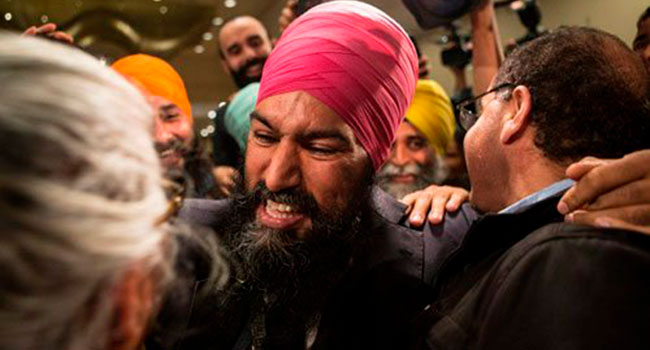 For the past 90 years, Canadian politics has been influenced by a genuinely left-wing political party.
For the past 90 years, Canadian politics has been influenced by a genuinely left-wing political party.
The Co-operative Commonwealth Federation (CCF) emerged in 1933. It demanded nationalization of essential industries, universal public pensions, health care, family allowances, unemployment insurance and workmen’s compensation.
Its Regina Manifesto boldly asserted, “No CCF Government will rest content until it has eradicated capitalism and put into operation the full programme of socialized planning which will lead to the establishment in Canada of the Co-operative Commonwealth.”
Despite achieving power in Saskatchewan in 1944 and then introducing medicare, the party never came close to ruling at the federal level. Even after a CCF alliance with big unions in 1961 produced the New Democratic Party (NDP), third-place standings were the usual order of the day.
This lack of electoral success doesn’t mean the left-wing group was without influence, as can be seen by the fact that many of its platforms are now widely accepted by other parties. Party leaders have tended to treat compromise for the sake of votes with scorn and to be content with being a principled voice in the wilderness.
In 2011, the future looked bright for the NDP. In that year’s federal election, under winsome leader Jack Layton, the party made a breakthrough in Quebec (hitherto an electoral wasteland) and won 103 seats across the nation to become the official Opposition.
The death of Layton soon after left the party in the hands of Tom Mulcair, a fluently-bilingual Quebec lawyer seen as a moderate and a safe pair of hands. His qualifications, however, did the NDP no good because it encountered the charmed offensive of Canada’s current Prime Minister Justin Trudeau in the 2015 election. The NDP lost 59 seats and sank again to third place in the House of Commons. Accusing fingers were pointed at Mulcair, who lost a leadership review and was forced to step aside.
The NDP held a vote for their new leader in 2017. The star quality of the candidates couldn’t be said to be outstanding; the four front-runners were worthy but dull: Charlie Angus, radical but little-known Niki Ashton, Guy Caron, and flashy Jagmeet Singh, who was not an MP at the time.
The race was complicated by rules mandating that candidates get at least 500 signatures from party members, at least half of which must be from female-identified members and at least 100 from “other equity-seeking groups,” including Indigenous people, LGBT people, persons with disabilities and visible minorities.
Singh won on the first ballot and NDPers dislocated their shoulders patting themselves on the back for choosing the first visible-minority leader of a Canadian federal party.
Glorious words were spoken about Singh’s chances in the coming election. He won a seat in the House of Commons through a byelection victory in Burnaby, B.C., far from his Scarborough, Ont., roots. His suits were impeccably tailored, his watch was a Rolex, he rode designer bicycles and drove a BMW, he practised martial arts.
His image could not have been further from the founding fathers of Canadian socialism, Tommy Douglas and J.S. Woodsworth. Toronto Life magazine prophesied that he had the makings of a “political superstar” who would make Trudeau jealous.
Sadly for NDP dreamers, the reality of Singh’s leadership has been disappointing:
- His abrupt dismissal of a Saskatchewan MP sparked a backlash in that province, formerly the heartland of the CCF.
- During the 2019 election campaign, his handling of the turban question was gracious but undoubtedly cost him votes in Quebec.
- Conflicting messages about what the party would do in the case of a minority government won it no friends.
- Worst of all, Singh’s ties to Sikh militancy in India, what the Globe and Mail called the “ethno-nationalist politics of another country and another time and place,” led many to wonder where his true loyalties lay.
When the smoke cleared on election night in 2019, the wreckage of the national NDP must have been dismaying for supporters: it had lost a half-million votes and 20 seats; it was shut out in Toronto and retained only a single MP in Quebec; it was now a fourth-place party. Mulcair might have been forgiven.
Since that election, NDP members can have few doubts that the future of the party is uncertain. They have been outflanked on the left by the Greens and the Liberals. The party’s links to agrarian socialism and the votes of working-class Ontario are now gossamer. It has no hope in secular Quebec as long as its leader wears a turban and the party opposes a ban on the niqab and other religious face covering. The only media attention Singh has won lately has been his petulant outburst against a Bloc MP that resulted in his temporary expulsion from the House.
This prompts two questions:
- Just who does the NDP speak for if it is no longer the sole progressive voice?
- Will it dare to move closer to the centre and pose as the responsible left-wing vote in the face of a Liberal party bent on seeing if it can crack the trillion-dollar debt barrier?
If Singh is the problem, who is there on the meagre parliamentary bench to replace him?
One might look to bilingual House Leader Peter Julian or sole Quebec MP Alexandre Boulerice as alternatives. Perhaps Winnipeg MP Leah Gazan for the Chinese-Jewish-Lakota demographic.
Most pressing, when the House reviews the Liberal government’s latest spending plans, will the NDP support a no-confidence motion and force an election that may well decide if the party has any future in Canadian politics?
I bet the NDP won’t support the no-confidence motion.
Gerry Bowler is a Canadian historian and a senior fellow at the Frontier Centre for Public Policy.
Gerry is a Troy Media Thought Leader. Why aren’t you?
For interview requests, click here. You must be a Troy Media Marketplace media subscriber to access our Sourcebook.
The views, opinions and positions expressed by columnists and contributors are the author’s alone. They do not inherently or expressly reflect the views, opinions and/or positions of our publication.

